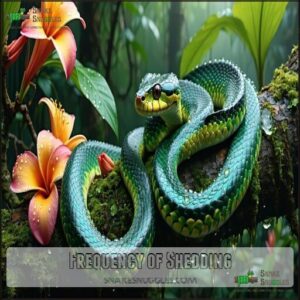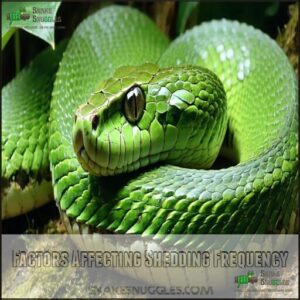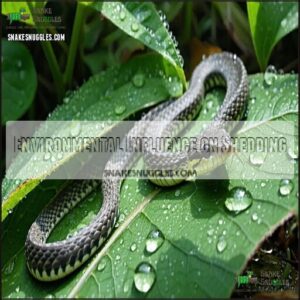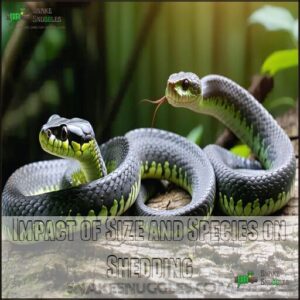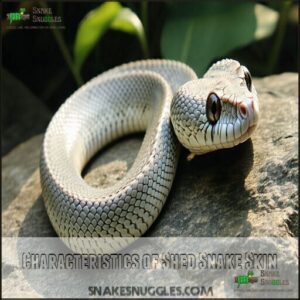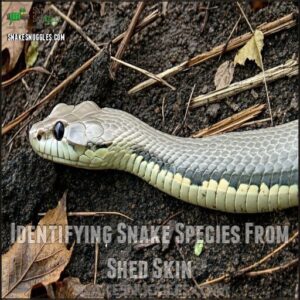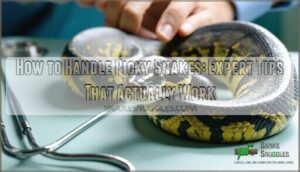This site is supported by our readers. We may earn a commission, at no cost to you, if you purchase through links.
 Snakes shed their skin, or molt, to grow and stay healthy.
Snakes shed their skin, or molt, to grow and stay healthy.
On average, they shed two to four times a year, but this depends on their age, size, and species. Younger snakes shed more often—sometimes every few weeks—since they grow quickly, while older snakes might only shed twice a year.
Shedding usually happens when a snake’s skin becomes too tight or damaged, much like outgrowing a favorite pair of jeans. Factors like temperature, humidity, and even daylight changes can influence the timing.
Keep an eye out for dull skin or cloudy eyes—signs a snake’s ready to shed. Curious about the process? There’s more to explore!
Table Of Contents
- Key Takeaways
- When Do Snakes Shed Their Skin?
- The Shedding Process of Snakes
- Environmental Influence on Shedding
- Factors Affecting Snake Movement During Shedding
- Impact of Size and Species on Shedding
- Behavior Following Shedding
- The Significance of Proper Shedding for Snake Health
- Recognizing Snake Shed Skin
- Frequently Asked Questions (FAQs)
- How long does a snake shedding last?
- How do snakes separate their old skin from the new layer?
- How does a snake shed?
- How do you know if a snake is shedding?
- What month do snakes shed skin?
- Do snakes stay close to where they shed their skin?
- What does it mean when you find a snake skin in your yard?
- Can you tell a snake by its shed skin?
- What time of year does a snake shed its skin?
- Do snakes go back to where they shed their skin?
- Conclusion
Key Takeaways
- Snakes shed their skin to grow and stay healthy, with younger snakes shedding more often than adults.
- Shedding is influenced by factors like age, species, diet, and environmental conditions such as humidity and temperature.
- Signs a snake is about to shed include dull skin, cloudy eyes, and reduced activity or moodiness.
- Proper shedding is crucial for a snake’s health, removing parasites and renewing skin, while incomplete sheds can cause infections or other health issues.
When Do Snakes Shed Their Skin?
Snakes shedding their skin is one of nature’s cool tricks. Shedding frequency depends on age and environment.
Shedding skin is a snake’s way of outgrowing the old and stepping into something fresh and functional.
Young snakes, growing fast, often shed every few weeks, while adults shed 4–12 times annually. Shedding triggers vary.
In the wild, shedding aligns with growth spurts or seasonal changes. In captivity, proper diet and humidity boost regular, healthy shedding.
Smaller species often experience more frequent molting cycles than larger ones. The process begins with dull skin and cloudy eyes as the snake prepares to shed.
Pay attention to shedding abnormalities, like stuck skin patches, which signal health issues. It’s all part of the snake life cycle—a natural way to grow and replace old, worn skin.
Understanding your snake’s needs helps encourage smooth shedding and healthy post-shed behavior, keeping your slithering friend comfortable year-round.
The Shedding Process of Snakes
During shedding, a snake replaces its old, worn skin with a fresh, healthy layer, ensuring proper growth and protection.
This process, called ecdysis, happens in stages and includes visible signs like dull skin and bluish eyes, which are key indicators of the shedding process, particularly the stage where the snake’s eyes turn bluish.
Frequency of Shedding
In terms of shedding frequency, not all snakes follow the same molting schedule.
Shedding, or ecdysis, is closely tied to factors like age, health, and environment. For younger snakes, growth happens fast, so they shed every few weeks, while adults typically molt 2-4 times a year.
Captive snakes with ideal conditions may shed even more frequently compared to their wild counterparts.
Key factors influencing shedding frequency include:
- Age and Shedding: Young snakes shed often due to rapid growth, while older ones take longer intervals.
- Health Influence: A well-fed, healthy snake sheds more predictably, while stress or illness can disrupt the cycle.
- Diets Impact: Nutritious diets promote growth, leading to more frequent molts.
- Species Variation: Different snake species exhibit unique molting patterns based on size, growth rate, and natural habitat.
By understanding these nuances, you can better care for snakes during their molting phases.
Factors Affecting Shedding Frequency
A snake’s shedding frequency is shaped by several factors, including age, diet, and environmental conditions.
Younger snakes shed more often due to rapid growth, while adults shed less frequently.
Diet and shedding are closely linked—a nutritious, balanced diet guarantees proper skin health.
Stable humidity levels support easy shedding, while dehydration or low humidity can cause stuck skin.
Stress, injuries, and parasites also impact frequency.
Genetic predisposition and a suitable snake diet further influence how often snakes shed.
Environmental Influence on Shedding
Environmental factors like temperature and humidity play a key role in how and when snakes shed their skin.
If the air is too dry or the temperature isn’t just right, it can make shedding harder and less frequent, which is influenced by environmental factors.
Seasonal Variations in Shedding
Shedding frequency often shifts with seasonal changes.
During warmer months like spring and summer, higher temperatures and prey availability encourage more frequent molts, as snakes stay active and grow.
On the flip side, winter slows things down; with cooler temperatures and lower humidity levels, snakes may enter brumation, conserving energy until conditions improve.
If you’re caring for one, providing the right environmental factors—think proper temperature and humidity influence—helps guarantee healthy, stress-free shedding throughout changing seasons.
Effect of Temperature and Photoperiod
Ever wonder how shedding cycles align with nature? Temperature and photoperiod influence a snake’s shedding process more than you’d think.
Temperature impact and photoperiod influence create a rhythm that keeps shedding frequency on track.
Here’s how these environmental factors shape shedding:
- Warmer temperatures (68–80°F) speed metabolism, increasing shedding frequency.
- Predictable light patterns stabilize cycles, critical in captive shedding.
- Longer daylight hours often trigger seasonal shedding and breeding events.
- Sudden temperature shifts may lead to unexpected shedding episodes.
- Consistent environmental control prevents shedding issues and stress.
Understanding these environmental conditions helps balance the shedding cycle and keeps your snake healthy, whether in the wild or captivity.
Remember that snakes rely on proper ecdysis techniques for healthy skin.
Factors Affecting Snake Movement During Shedding
Shedding skin makes snakes more sluggish and cautious, as their vision can become temporarily impaired.
Environmental factors like humidity and surfaces for rubbing play a big role in how easily they move during this process, which can be considered a complete and critical aspect of their behavior.
Impact of Stress and Disturbance
Shedding stress can disrupt the delicate process of snake shedding, leading to health consequences like incomplete molts.
Environmental disruption and snake handling often delay shedding frequency, especially in captivity.
Noise, sudden light changes, or frequent handling increase snake stress, making it harder to shed properly.
Even fluctuations in temperature or overcrowding can lead to stubborn skin retention.
Minimizing disturbances is key—maintain consistent environmental factors to help your snake shed smoothly and stay healthy.
Role of Environmental Conditions
Environmental conditions have a big say in how snakes shed their skin.
These factors guide where snakes settle during shedding, directly impacting their health and comfort.
Proper conditions, like the right mix of humidity levels and temperature effects, are essential for smooth shedding.
Snakes prefer warm, sheltered spots where they can easily remove old skin.
High humidity levels prevent their skin from drying, which is especially important during dry periods.
Seasonal shedding patterns also play a role, with weather changes pushing snakes to adjust their habitat choices.
Climate change is even reshaping traditional behaviors, forcing snakes to adapt to new environmental conditions.
In captive environments, it’s critical to maintain consistent humidity and temperature to support healthy snake shedding.
- Temperature effects: Warm areas speed up shedding.
- Humidity levels: Essential for proper skin turnover.
- Habitat influence: Poor conditions lead to complications.
- Seasonal shedding: Weather shifts guide shedding patterns.
Impact of Size and Species on Shedding
Shedding frequency in snakes depends a lot on their size and species, with smaller, faster-growing snakes shedding more often than larger ones.
Different species also have unique growth rates and skin renewal needs, influencing how often they shed their skin.
Variances in Shedding Behavior Among Species
Different snake species have unique shedding patterns, shaped by habitats, diets, and genetic factors. Some snakes move through shedding quickly, while others take their time depending on their lifestyle and environment.
In captivity versus the wild, factors like controlled humidity and regular feeding often lead to more frequent shedding in captive snakes.
Here’s a quick comparison of snake species shedding rates:
| Species | Shedding Frequency |
|---|---|
| Garter snake | 2-3 times per year |
| Rattlesnake | 1-3 times per year |
| Corn snake | 4-6 times per year |
| Boa constrictor | 4-6 times per year |
| Ball python | 3-4 times per year |
Snake molting frequency also depends on their age and role in the ecosystem. Younger snakes grow faster and shed more often, while adults shed less frequently.
Habitat shedding differences are notable; species in warm, humid climates often shed more easily than those in drier areas. Ball pythons, for instance, require careful attention to humidity and temperature to facilitate proper shedding.
Influence of Snake Size on Shedding Frequency
The role of size in snake shedding frequency is fascinating and practical for snake owners to understand.
Juvenile snakes shed more often due to rapid growth spurts.
They might molt every couple of weeks, driven by their need to grow quickly and replace worn skin.
In contrast, adult shedding frequency (or Adult Frequency) slows to about 2-4 times a year since their growth rate is steadier.
Larger snakes typically shed less frequently than smaller species, but their size and strength allow for a smoother shedding process.
Snake size directly impacts how efficiently they shed, as larger bodies mean more strength to remove old skin.
Snakes shed to facilitate growth and health.
- Juvenile shedding occurs every few weeks during rapid growth.
- Adults generally shed 2-4 times per year.
- Faster growth rates increase molting cycles.
- Species variation also influences molting patterns.
Behavior Following Shedding
After shedding their skin, snakes often become more active and may seek food to replenish their energy.
You’ll also notice that their colors appear vibrant, as the fresh skin enhances their natural patterns.
Observations on Post-Shedding Behavior
Snakes exhibit fascinating patterns of behavior immediately after the shedding process.
Freshly shed individuals often prioritize rest and recovery.
You’ll notice signs like sluggish movement and a tendency to seek dark, humid spaces, which aid skin hardening and protect against the vulnerability window that follows shedding.
During this period, snakes display more defensive behavior, staying cautious and alert to potential threats.
As their new skin toughens and they regain confidence, their movements become more active.
Many snakes show immediate activity, testing their surroundings and re-establishing familiar routes.
Post-shed feeding is another key behavior, as they replenish energy lost during the shedding process.
Examining the shed can help identify potential dermatological issues.
This phase is important for understanding snake behavior.
Their heightened awareness and calculated movements highlight the remarkable balance between recovery and survival in the wild.
Observing these post-shed patterns truly showcases nature’s resilience and the importance of recovery and adaptation.
Inferences From Studies and Case Observations
Post-shedding behavior gives us a deeper look into the lives of snakes.
Studies show that after the shedding process, snakes regain sharp vision, as old eye caps fall away.
This boosts their hunting and navigation abilities almost instantly.
You might notice that in the shedding timeline, vision impairment earlier on makes them defensive, but this fades as their shedding anomalies resolve naturally.
Wild snakes often return to familiar spots, showing strong site fidelity.
These locations usually have the right temperature and humidity to support their recovery.
Captive vs. wild snakes may differ here, as the controlled environment simplifies these choices.
However, observational biases in studies remind us to reflect on data limitations.
Longitudinal studies continue refining knowledge about snake growth and movement.
-
Key post-shedding behaviors include:
- Brightened, clearer appearances.
- Restored hunting instincts.
- Seeking humidity-rich areas.
- Return to safe, familiar environments.
The Significance of Proper Shedding for Snake Health
When a snake sheds its skin properly, it helps maintain healthy growth, remove parasites, and prevent infections.
Any incomplete shedding can cause serious problems, like damage to the eyes or restricted blood flow.
Health Risks of Incomplete Shedding
An incomplete shed, or dysecdysis, can spell trouble for snake health if ignored. That stuck shed isn’t harmless—it traps moisture, increasing infection risks like scale rot.
Eye cap retention is particularly hazardous, potentially leading to vision loss. When shedding problems persist, infection risks skyrocket, threatening your snake’s well-being.
Maintaining proper humidity is key, and many owners find success with specialized enclosure products.
| Issue | Cause | Remedy |
|---|---|---|
| Infection | Stuck skin, poor hygiene | Soak or consult a vet |
| Eye Damage | Retained eye caps | Improve humidity levels |
| Blood Flow Issues | Skin constrictions | Warm soaks, vet checkup |
| Death | Severe shedding issues | Preventative care practices |
Never ignore signs like retained scales or dull-looking skin, as these point to underlying shedding problems. Focus on preventative care—keep humidity levels right and make certain proper nutrition. If problems persist, don’t hesitate. Consult a reptile health professional to avoid long-term complications, stress, or even life-threatening conditions.
Importance of Shedding for Physical Well-Being
Healthy shedding isn’t just about looks—it’s how snakes keep their bodies working smoothly.
Healthy shedding keeps snakes growing, healing, and parasite-free, ensuring vibrant skin and smooth movement essential for survival.
Their shedding process is like hitting reset for their skin, helping them grow, heal, and stay clean.
- Skin Regeneration: Fresh skin allows the body to expand, supporting proper growth accommodation.
- Parasite Removal: Shedding gets rid of pesky mites and ticks that cling to old skin.
- Injury Repair: New skin replaces damaged areas, offering protection from infections.
- Hydration Benefits: Proper shedding supports moisture balance, keeping the skin flexible.
Snakes shed old skin like upgrading to something sharper and stronger.
Without healthy shedding, they risk infections, impaired movement, or even vision problems.
Addressing issues with snake shedding products can help to guarantee a healthy shed.
It’s nature’s way of keeping them ready for anything.
Recognizing Snake Shed Skin
You can recognize shed snake skin by its translucent, fragile appearance, often left behind in one long piece.
Look closely at the scale patterns and size, as they can help you identify the snake species that left it.
Characteristics of Shed Snake Skin
A snake’s shed skin is like a detailed map of its body. You’ll spot intricate scale patterns and unique skin textures that mirror the snake’s form.
The shed size often seems larger due to the stretchable nature of snake skin. Fresh sheds appear vibrant but fade with time.
Look for attached eye caps, translucent layers, and even hints of previous coloration clues. When handling, use gloves to avoid mites or allergens.
Proper identification can be aided by examining shed quality. Shed skins beautifully reflect the shedding process and aid in snake skin identification, which is crucial for understanding the unique characteristics of a snake.
Identifying Snake Species From Shed Skin
Identifying snake species from shed skin is like solving nature’s puzzle.
Look closely at these features:
- Scale patterns: Venomous snakes usually have single rows of tail scales, while non-venomous ones show double rows.
- Banding coloration: Even faded patterns can hint at the species.
- Skin size: Longer sheds often belong to larger snakes.
- Venomous identification: Pay attention to distinct tail scale arrangements.
Combine these clues with your location and a species guide for accurate snake skin identification, whether venomous or nonvenomous.
Frequently Asked Questions (FAQs)
How long does a snake shedding last?
The entire shedding process usually takes 10 to 14 days from start to finish.
You’ll notice dull skin and cloudy eyes early on, but after shedding, the snake will look fresh, vibrant, and renewed!
How do snakes separate their old skin from the new layer?
To separate old skin from the new layer, snakes create a fluid layer beneath it.
They rub their snout against rough surfaces, loosening the skin, then crawl out, leaving the old layer turned inside out.
How does a snake shed?
Shedding starts when a snake’s skin loosens and its eyes turn milky blue.
It rubs against rough surfaces to peel off the old layer, leaving a fresh, shiny skin behind in one smooth piece.
How do you know if a snake is shedding?
You’ll notice a snake’s skin dulling, its eyes turning milky blue, and a slight pinkish belly.
It becomes less active, moody even, rubbing its face against rough surfaces—classic signs it’s gearing up to shed.
What month do snakes shed skin?
Snakes don’t follow a specific calendar month to shed; it happens year-round.
Shedding depends on factors like age, species, and environment.
Younger snakes shed more often, while adults shed a few times annually, with younger snakes being a key factor in the frequency of shedding.
Do snakes stay close to where they shed their skin?
Around 75% of snakes stay near their shed skin briefly, using the area for safety while their new skin hardens.
They usually hide nearby to avoid predators, so staying observant is always a good idea.
What does it mean when you find a snake skin in your yard?
Finding snake skin in your yard means a snake has been nearby, likely seeking food or shelter.
It signals a healthy, growing snake and a suitable environment.
Stay cautious, but there’s no need to panic.
Can you tell a snake by its shed skin?
You can identify a snake by its shed skin through scale patterns, especially underneath the tail.
Venomous snakes usually have single tail scales, while non-venomous ones show double rows, offering essential clues.
What time of year does a snake shed its skin?
You won’t find a set season for snakes to shed.
Shedding happens year-round, influenced by age, species, health, and environment.
Younger snakes shed more often.
Warmer weather and high humidity can increase shedding frequency.
Do snakes go back to where they shed their skin?
Snakes don’t usually return to where they shed their skin.
Once they’ve moved on, they’re primarily focused on safety and finding food.
The shed skin, however, can indicate their presence in the area.
Conclusion
Imagine a snake slipping out of its old, dull skin like stepping out of a snug jacket—it’s a necessary process for growth and health.
Understanding when snakes shed their skin helps you recognize key signs, like cloudy eyes or faded scales, and the factors affecting shedding, such as age, size, or environment.
By observing these details, you can guarantee the best conditions for their well-being and spot potential problems, guaranteeing every shed is complete and stress-free.

